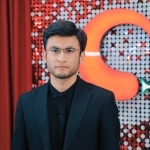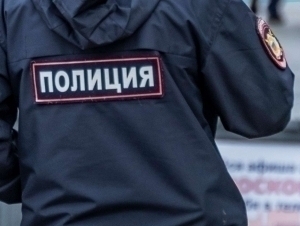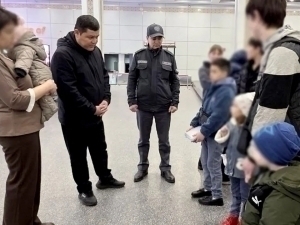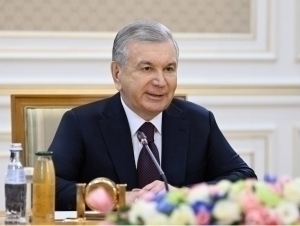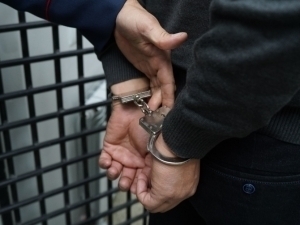MIDWEEK: Merkel’s party wins, Trump and Putin clash, and Zelensky weighs his options
Review
−
26 February 7507
Trump managed to corner Zelensky with proposals that were difficult to reconcile. In the last few hours, reports have spread that the Ukrainian President has accepted a slightly lighter version of the agreement, which envisages the transfer of a large part of the natural resources to the United States, which he rejected three times.
European Union officials, however, have stated that they will never impose such a demand on Ukraine and will continue to apply it.
Trump's four-year term may be a completely new era in Russian-US relations. Official circles in Moscow and Washington seem to be close to cooperation on everything from peace to natural resources. And the proposals have already been made.
QALAMPIR.UZ's Midweek program with details of important events that have occurred in the world until the middle of this week.
Zelensky’s Deadly “Doors”
Since Trump came to power, negotiations have been underway on an agreement that would give Ukraine access to mineral resources. These issues have been discussed many times through Vice President James David Vance, Treasury Secretary Scott Bessent, and Trump’s special representative for Ukraine-Russia relations, Keith Kellogg. According to Ukrainian sources, the idea of the agreement was put forward by Ukraine in September 2024. Then, Ukrainian President Volodymyr Zelensky proposed granting the United States mining rights in exchange for future security assistance and an invitation to NATO. However, US President Donald Trump thwarted official Kyiv’s plans by demanding Ukrainian resources and infrastructure as compensation for the assistance that Washington had already provided to Kyiv. It was this factor that caused a rift between Zelensky and Trump.
In recent days, Trump has been widely known for his insults to Zelensky from across the ocean and the Ukrainian President’s responses to them. The Economist recently cited three proposals submitted by the US and Ukraine in the negotiations over natural resources and security guarantees requested by Kyiv in return, which the Trump administration is unwilling to provide. According to the publication’s sources, since the start of the negotiations, Ukrainian officials have met with three successive groups of US negotiators, each of whom has put forward a different version of the agreement.
The first version of the agreement is called “bad.” It was presented to Zelensky by US Treasury Secretary Scott Bessent on February 12. In it, the American minister presented an agreement that would require the Ukrainian President to pay the United States the equivalent of $500 billion in natural resources in exchange for the assistance provided to date. However, it did not provide for the provision of security guarantees in exchange for the receipt of Ukrainian natural resources. Zelensky was reportedly “very angry” with this proposal during the negotiations with Bessent.
The second version of the agreement is called the “relatively better” of all the proposed projects. It was presented to the Ukrainian side by Trump’s special representative for Ukraine and Russia, Keith Kellogg, and US Vice President James-David Vance at the Munich Security Conference. According to The Economist, like the first version, the second version did not contain any promises of defense assistance to Ukraine. Simply put, it was “all you get, no you don’t.” If you remember, it was after this Munich conference that a civil war broke out between Trump and Zelensky. Initially, when it became clear that the US-Russia talks in Riyadh would take place without Ukraine, Zelensky announced that Kyiv would not recognize any of the results of this meeting. Trump then raised the issue of its legitimacy, even going so far as to call Zelensky a “dictator without elections.” Meanwhile, the Ukrainian President announced that he could not sell Ukraine, saying that the agreement proposed by the US did not include security guarantees and that it was the same reparations imposed on Germany and its allies after World War II.
Today, it is becoming clear that Zelensky and Trump could not agree on the two proposals mentioned above in those days when these conflicts occurred. Of course, it was natural for Kyiv to be offended by such proposals from Trump, which were nothing more than “economic dependence.”
But it would not be wrong to say that this was “the last straw.” According to The Economist, on February 20, Kyiv was presented with a third version of the agreement—the most “disastrous” one yet. Under this proposal, the United States demanded that Ukraine transfer 50 percent of its future state revenues from natural resources and infrastructure, including ports, to a newly established investment fund owned by the US government. Contributions to this fund were to continue until it accumulated a total of $500 billion.
Kyiv was reportedly “shocked” by this unexpected proposal. The author of this controversial offer was said to be US Secretary of Commerce Howard Latnick. One Ukrainian official, speaking to the publication, warned that if this proposal were accepted, the people could execute them without trial the very next day.
This raised serious doubts about Ukraine’s future reliance on US aid. It became evident that Trump was unwilling to assist without securing control over a significant portion of the country's natural resources—resources that belong to the Ukrainian people. Even more concerning, his proposals did not include assurances for Ukraine’s security, despite demanding vast economic concessions. Initially, negotiations seemed to reach an impasse.
However, according to Ukrainian sources cited by The Economist, talks did not collapse entirely. Reports emerging in the last few hours indicate that negotiations on natural resources have now been concluded between Kyiv and Washington. The Financial Times (FT), citing Ukrainian officials, stated that Washington ultimately backed down from its most stringent conditions—most notably, the demand for full US ownership of the projected $500 billion in revenues from Ukrainian mineral resources.
Sources suggest that Kyiv managed to secure more favorable terms, perceiving the final deal as an opportunity to strengthen cooperation with the United States. The fourth and final version of the agreement, approved on February 24, outlines the creation of a special fund. Ukraine will allocate 50 percent of its income from mineral, oil, and gas production to this fund, which will be used exclusively for domestic investment projects. Importantly, existing state resources will remain unaffected, meaning that major oil and gas companies such as Naftogaz and Ukrnafta will continue operating without changes.
However, the deal does not include the security guarantees Kyiv had previously demanded. Additionally, several ambiguities remain unresolved. Specifically, the US share in the fund and the mechanisms for joint asset management are still open to further negotiations. The agreement has already been approved by Ukraine’s Ministers of Justice, Economy, and Foreign Affairs and now awaits ratification by the Verkhovna Rada. In the coming weeks, Ukrainian President Volodymyr Zelensky is expected to visit the United States to officially sign the agreement with President Donald Trump.
Europe Wants to Continue Supporting Ukraine
European leaders have increasingly come to realize that they must take responsibility for Ukraine's security—and that of the entire continent—following Trump's unexpected reaction. In response, they have intensified both symbolic and practical support for Ukraine, which remains under occupation.
On the morning of February 24, marking the third anniversary of Russia's full-scale invasion, European Commission President Ursula von der Leyen and European Council President António Costa arrived in Kyiv. The two senior European politicians expressed solidarity with Ukraine and pledged additional assistance to the country in the face of ongoing Russian aggression. Upon her arrival in the Ukrainian capital, von der Leyen emphasized on Platform X that Ukraine's fight for survival was not only about its fate but also about the future of Europe as a whole.
On the same day, Ukrainian President Volodymyr Zelensky announced that in addition to von der Leyen and Costa, heads of state and government from 13 other countries would also arrive in Kyiv. The visit by EU leaders was not merely symbolic. Notably, Ursula von der Leyen announced that she would soon present a comprehensive plan aimed at expanding arms production and strengthening the EU's defense capabilities—measures from which Ukraine should also benefit. Additionally, she highlighted further steps to enhance the energy security of both Ukraine and the European Union. She also promised that the Ukrainian and Moldovan electricity markets would be fully integrated into the European energy system by the end of next year.
Meanwhile, German President Frank-Walter Steinmeier, in his address marking the third anniversary of Russia's invasion of Ukraine, reaffirmed Berlin's commitment to supporting Kyiv. He stated that Germany's assistance would continue through humanitarian aid, protection for those who had fled the war, and military aid. He further stressed that Germany would not cease its support until the invasion was over. Additionally, Germany pledged to participate in the reconstruction of Ukrainian cities devastated by Russian attacks and vowed to spare no effort in helping Ukraine return to peaceful life.
Reports have also emerged that the United Kingdom and France are preparing a plan to deploy up to 30,000 European peacekeepers to Ukraine following a peace agreement. According to The Wall Street Journal (WSJ), British Prime Minister Keir Starmer intends to present a draft version of the plan to Trump during his meeting with the White House Chief of Staff in Washington on February 27. Sources indicate that the initiative is being led by the British government.
Meanwhile, French President Emmanuel Macron has already discussed the matter with the US President. On February 24, during his visit to Washington, Macron met with Donald Trump at the White House to discuss the situation in Ukraine and the next steps forward. Macron stated that Europe was ready to provide security guarantees to Ukraine—on the condition that a ceasefire is reached. In this context, the previously announced plan for sending peacekeeping forces to Ukraine is being considered as a viable option. Furthermore, Macron suggested that a ceasefire in Ukraine could be reached in the coming weeks.
Trump has repeatedly stated that he does not oppose the deployment of European peacekeeping forces in Ukraine. He even mentioned that he had discussed the issue with Russian President Vladimir Putin and that Putin had not objected. However, the Kremlin had previously stated that Russia did not view the deployment of European troops in Ukraine favorably. Despite this, the French President remains adamant that both the peacekeeping force and the overall strengthening of the Ukrainian military are essential. Macron argued that lasting peace in Ukraine could only be achieved with the necessary defense capabilities, estimating that 800,000 troops would be required. He pointed to Ukraine’s insufficient armed forces at the time of the initial invasion as one of the factors that enabled the Russian assault, which has now continued for three years.
Trump and Putin Are at Loggerheads
In recent days, former allies Donald Trump and Vladimir Putin have appeared closer than ever. Trump has consistently defended Putin at every opportunity. For example, during a press conference held during French President Emmanuel Macron's visit to the United States, Trump refused to label Putin a "dictator." This came just a week after he denounced Ukrainian President Volodymyr Zelensky as a "dictator" for refusing to hold elections during wartime.
However, the most unexpected development occurred at the United Nations General Assembly on February 24. On the third anniversary of Russia’s full-scale invasion of Ukraine, the General Assembly adopted a resolution condemning Moscow. In a surprising turn, the United States voted against the resolution, aligning itself with Russia. This decision marked one of the most significant shifts in U.S. policy regarding Ukraine since the war began. The resolution was backed by 93 out of 193 member states, while 18 countries, including the U.S. and Russia, voted against it. Meanwhile, 65 nations—including Uzbekistan—chose to abstain.
These events underscore the strengthening ties between Trump and Putin. The two nations are also exploring deeper cooperation in the natural resource sector. Russian President Vladimir Putin has even extended an offer to the United States for joint extraction of rare metals on Russian territory. On February 24, in an interview with his frequent correspondent Pavel Zarubin, Putin suggested that the U.S. and Russia collaborate on aluminum production.
“We can consider cooperation with American companies in this area. For example, in the Krasnoyarsk Territory, even during Soviet times, there were plans to construct a new hydroelectric power plant and expand aluminum production capacities. Preliminary estimates suggest that the project would be valued at approximately $15 billion at today's prices, but we can explore this possibility,” Putin stated.
The Russian President also acknowledged that Russia has not made sufficient progress in developing its rare earth metal industry. However, his specific focus on the aluminum sector was no coincidence. Just before Putin’s interview with Zarubin, the European Union had announced its 16th package of sanctions against Russia, which heavily targeted the Russian aluminum industry. Given these circumstances, strengthening economic ties with the U.S. in this sector has become a strategic priority for Moscow.
There are additional signs that U.S.-Russia relations could become even closer over the next four years, particularly in economic cooperation. One significant indicator is Putin’s recent appointment of Kirill Dmitriyev, the head of the Russian Direct Investment Fund, as Russia’s special representative for international economic cooperation. Dmitriyev, who has been actively involved in high-level diplomatic discussions, was part of a Russian delegation that met with American diplomats in Riyadh on February 18. Alongside Kremlin foreign policy adviser Yuri Ushakov and Russian Foreign Minister Sergei Lavrov, Dmitriyev participated in talks focused on economic cooperation with the U.S. Calls for increased investment in Russia were also raised during the meeting in Riyadh.
These developments suggest that despite their past differences, Moscow and Washington may be on the verge of closer collaboration in key economic sectors, reshaping global geopolitical dynamics.
Merkel's Party Returns to Power
A snap election for the Bundestag was held across Germany on February 23, with 29 political parties participating. More than 59 million eligible voters cast their ballots in an election that pre-election polls suggested would see the ruling party lose power. Surveys indicated that the conservative CDU/CSU bloc was the most favored, followed by the far-right Alternative for Germany (AfD), while the ruling SPD and the left-liberal Greens were projected to finish in third place.
The final results confirmed these projections. Friedrich Merz's Christian Democratic Union (CDU) and Christian Social Union (CSU) alliance won the parliamentary elections with 28.6 percent of the vote. For the first time in its history, the AfD secured second place with 20.8 percent. The party, which has been active for 12 years and recently gained support from key figures in the new U.S. administration, including Elon Musk and Vice President Vance, surprised many with its success. Meanwhile, the ruling Social Democratic Party of Germany (SPD) recorded its worst-ever result, finishing third with 16.4 percent. This outcome means that incumbent Chancellor Olaf Scholz will step down from office, and the leader of the winning CDU/CSU alliance, Friedrich Merz, will take over as Chancellor.
The CDU/CSU alliance will hold 208 seats in the Bundestag, with the CDU securing 151, the SPD 121, the Greens 85, and the Left Party 64. Additionally, one independent candidate won a seat. Chancellor-designate Friedrich Merz announced plans to form a government by Easter, specifically by April 20. However, to do so, he must form a coalition with other parties that secured a significant number of votes. Some analysts believe this will be challenging, as no party is expected to ally with the far-right AfD due to Germany’s political norms, which regard cooperation with extremist parties as unacceptable.
Nonetheless, Merz’s alliance recently relied on AfD’s support to pass a bill tightening migration policies in the Bundestag, a move that sparked widespread criticism. This controversial political maneuver even drew sharp objections from former Chancellor Angela Merkel, who strongly criticized Merz’s actions. Given this, the possibility of a coalition remains uncertain. Additionally, as previously noted, AfD enjoys support from influential U.S. officials, which could further complicate the political landscape. Despite repeatedly ruling out a coalition with the far right, Merz faces a complex political dilemma.
Although Scholz acknowledged Merz’s victory and congratulated him, he has made it clear that he does not intend to work in a government led by him. However, the CDU/CSU alliance must secure a coalition, as it lacks an outright majority in the Bundestag. Failure to do so could result in a political deadlock and potentially trigger new elections. To maintain their victory, the CDU/CSU-led coalition must secure at least 316 out of the 630 Bundestag seats. The combined seats of Merz’s and Scholz’s parties total 329, a sufficient number for a coalition government. However, the outcome depends on the negotiations among political parties, with less than two months remaining until April 20.
Live
All